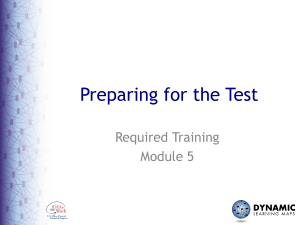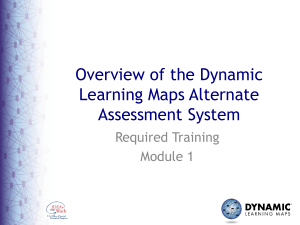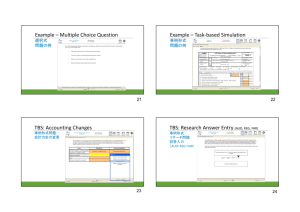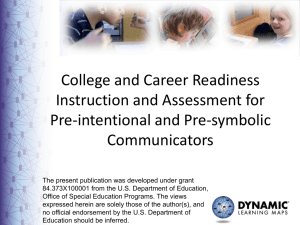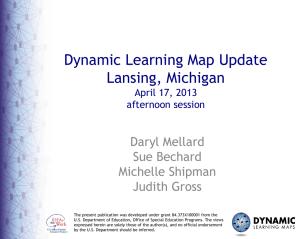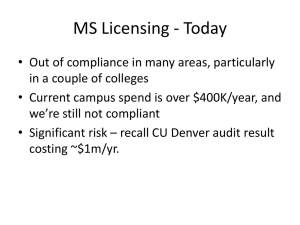pptx - Dynamic Learning Maps
advertisement
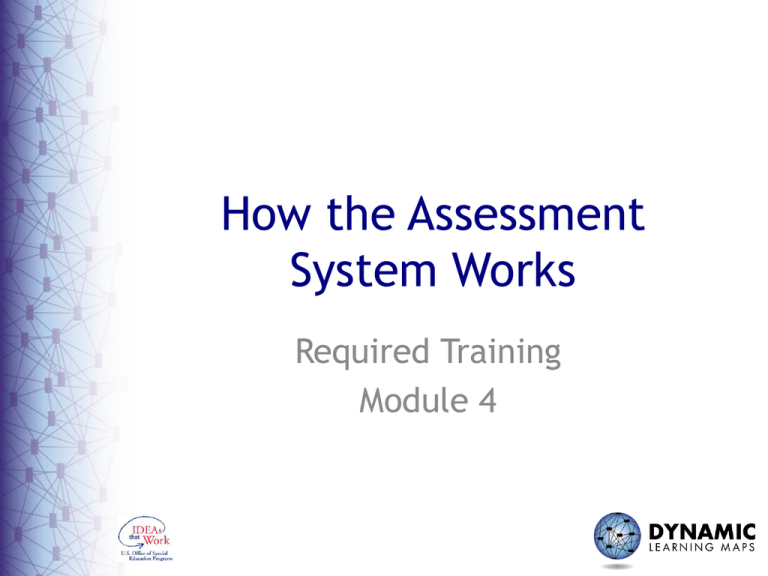
How the Assessment System Works Required Training Module 4 Learning Objectives 1. Assessment system design – Content – Test design – Testing windows & testlet delivery 2. Test results ASSESSMENT SYSTEM DESIGN Content of the Assessment • Grades 3-8 and high school – English Language Arts (ELA) – Mathematics • Blueprints: – Consortium approved a subset of Essential Elements – Consortium set minimum requirements for breadth of coverage ELA Content Coverage Example 3rd grade: • At least three EEs in C1.1 including RL and RI (eight available) • At least two EEs in C1.2 from different strands (five available) • At least one EE in C1.3 (two available) • All students take one writing assessment (one available) Math Content Coverage Example 3rd grade: • At least two EEs from two conceptual areas in claim 1 (four available) • One EE in claim 2 (one available) • At least two EEs in claim 3 (three available) • At least one EE in claim 4 (three available) Recording Content Choices • Teachers create instructional plans in the Instructional Tools Interface (ITI) in Educator Portal • Confirm assignment once ready to test • System delivers a testlet and testlet information Instructional Tools Choose Linkage Level • System makes recommendation • Teacher can accept or override • Review linkage level descriptors to find best match for the student Instructional Tools Test Design Instructionally Embedded Spring (End of Year) • One testlet per EE chosen in ITI • Five testlets per subject – Teacher chooses linkage level • Each testlet assigned separately • Test administrator schedules sessions within testing windows – System chooses EEs from within original set of teacher choices – System chooses linkage levels • Each testlet assigned separately • Test administrator schedules sessions within window What a testlet looks like • Reading and math – Each testlet aligns to a single EE – 3-5 items per testlet – Engagement activity • ELA: Built around a grade-level appropriate text; first read-through is engagement activity • Engagement activity sparks prior knowledge • Writing – Structured activity with several steps – Single testlet measuring multiple EEs TESTING WINDOWS & TEST DELIVERY Instructionally Embedded Windows • Begins in November 2014 – Multiple windows • Combination of operational and field test content in 2014-15 Instructionally Embedded Windows Steps: 1. Return to ITI and confirm content choices 2. Retrieve testlet information 3. Administer testlet Spring Window • Purpose: to update and validate information about student performance • States choose window within the consortium window • 5 testlets per subject – Subset of teacher’s choices from blueprint – System chooses linkage levels Testlet Delivery System has testlets available at all 5 linkage levels for every EE Students take one testlet from one level for each EE System determines which level to deliver to the student EE 1 EE 2 EE 3 EE 4 IP IP IP IP DP DP DP DP PP PP PP PP T T T T S S S S Testlet Delivery EE 1 EE 2 EE 3 EE 4 IP IP IP IP DP DP DP DP PP PP PP PP T T T T S S S S Testlet Delivery EE 1 EE 2 EE 3 EE 4 IP IP IP IP DP DP DP DP PP PP PP PP T T T T S S S S Testlet Recommendations & Assignments ASSESSMENT RESULTS Results • Will be based on mastery of EEs and linkage levels assessed • From assessments given all year –Newer information updates older information Score Reports • Will be provided at individual student level • Will include multiple levels of information – Essential Element mastery – Conceptual area summary – Overall performance
